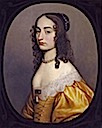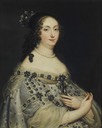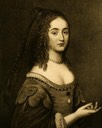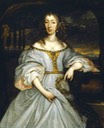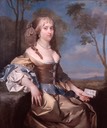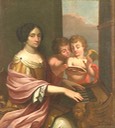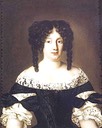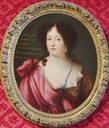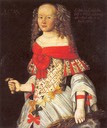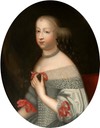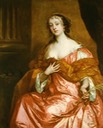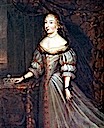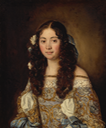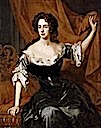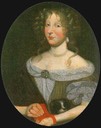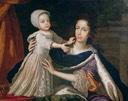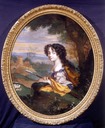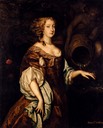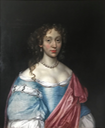This was a turbulent era,. In the UK, Charles I was executed in 1649, leading to a republic led by a father and then his son à la Kim Il-sung, Kim Jong-il, and Kim Jong-un. The people in the UK were happy to see royal rule restored in 1660. But religion continued to plague the country, particularly because Charles II's successor was Catholic. Parliament asked the daughter of Henrietta Mary Stuart, Mary, and her husband William to take the crown, done in 1689. Charles II was not to be outdone in the infidelity department by Louis XIV. Two of his mistresses are the subjects of subalbums, Barbara Palmer and French superspy Louise de Kerouaille.
In France, underage Louis XIV became King in 1643. He assumed complete power in 1661, but there were some troubles in the meantime. Local courts of appeals (parlements, not to be confused with legislative parliaments as in London) resisted increasing royal power being pursued by Cardinal Mazarin leading to a resistance. According to Wikipedia's article about Louis XIV, "A mob of angry Parisians broke into the royal palace and demanded to see their king. Led into the royal bedchamber, they gazed upon Louis, who was feigning sleep, were appeased, and quietly departed. The threat to the royal family and Monarchy prompted the Regent Anne (the subject of a subalbum) to flee Paris with the young King and his courtiers." The Fronde parlementaire petered out, but the hereditary nobles resisted expanding royal power (taxation and demoting them from vassals, with a major role in war, to mere courtiers adorning the royal court) leading to a second Fronde, the Fronde des princes, from 1650 - 1653. Many leading nobles, including the Duchesse de Longueville, participated. Cardinal Mazarin ultimately triumphed and royal authority was restored. No doubt with memories of the Fronde ever fresh in his mind, Louis XIV imposed absolute rule. Internal strife waned, but Louis XIV engaged in numerous border wars. In one triumph, he brought German states near France into the French orbit, something undone only in 1870 by Bismarck.
Louis XIV was married to a Habsburg Princess, Marie Thérèse of Austria/Spain, but is famous for his string of mistresses, the true leaders of fashion. Four are the subjects of subalbums, Marie Anne and Olympia Mancini, Louise de la Valliere, and the Marquise de Montespan. He was also involved with the Duchesse de Fontanges.
The Netherlands attained independence, but the Habsburgs still ruled what is now Belgium. In the next century, Marie Antoinette did not attempt to flee to Austria. She attempted to flee to Habsburg Belgium and was caught at Varennes near the Belgian border.
Germany and Italy were assemblages of various kingdoms, principalities, and ecclesiastical entities, somewhat recalled by the "Duchy of Grand Fenwick" in the 1959 film comedy The Mouse that Roared. Religion was still a source of intense conflict in Germany, and just about everywhere else in Europe, with the north turning protestant while the south remained Catholic.
Why end this album at 1683? This is when Louis XIV married Madame de Maintenon who exerted a profound influence on him. This may have contributed to the rigidity of that period.

Penelope, Lady Herbert (1620–1647) after Michael Dahl I (Newstead Abbey - Nottingham, East Midlands UK)

Julienne Hippolyte Joséphine d'Estrées, 1ère. duchesse de Villars-Brancas, Marquise de Graville et de Cérisay by ? (location ?)

ca. 1642 Lady Elizabeth Cavendish as a bride by ? (Ashridge Business School, Egerton collection - Berkhamsted, Hertfordshire UK)

1643 Henriette Luise von Württemberg by Benjamin Block (Plassenburg in Kulmbach - Kulmbach, Bayern Germany)

ca. 1643 English noblewoman and noblewoman of Brabant by Wenceslaus Hollar (Museum of London - London, UK)

Maria Eufrosyne, 1625-1687, prinsessa av Pfalz-Zweibrücken attributed to Hendrik Munnichhoven (Nationalmuseum - Stockholm, Sweden)

1653 Maria Eufrosyne av Pfalz-Zweibrücken by Hendrik Munnichhoven (Gripsholms slott - Mariefred, Södermanland, Sweden)

Honourable Miss Leigh (d.1688), Viscountess Tracy by ? (Lamport Hall - Lamport, Northamptonshire UK)

1640s Eleonora Katarina of Pfalz-Zweibrücken, princess of Sweden by ? (Skoklosters slott - Skoklosters Sweden)

Thomas Howard and Alathea Talbot by Sir Anthonis van Dyck (Arundel Castle - Arundel, West Sussex UK)

Anne Lindsay, Duchess of Rothes by David or John Scougal (Clan Leslie Charitable Trust - Leslie, Fife UK)

Lady Elizabeth Percy (1636-1717), wife of Arthur Capel by Sir Peter Lely (Watford Museum - Watford, Herts UK)

Jemima, née Carew, 1st Countess of Sandwich (1625–1674) by the studio of Sir Peter Lely (Mount Edgcumbe House - Torpoint, Cornwall, UK)

1648 or 1651 Anna Margareta von Haugwitz by Matthaeus Merian the Younger (Skokloster slott - Uppsala, Uppsala (County), Sweden)

1650 Bobbin lace glove conventional plant form Brides connect with outline of glove. Double ruffle along top and half one side of glove. Remains of faded stiff pink ribbon bow trimming (Museum of Fine Arts - Boston, Massachusetts USA)

ca. 1650 Dorothy Countess of Sunderland by Sir Anthonis van Dyck (Carmarthenshire Museums Service Collection, specific location unknown to gogm - Carmarthenshire, UK)

Dorothy Sidney, Countess of Sunderland by Sir Anthonis van Dyck (Lamport Hall - Lamport, Northamptonshire UK)

Miniature of Lady Penelope Compton, Wife of Sir Edward Nicholas by Samuel Cooper (Lewis Walpole Library, Yale University - New Haven, Connecticut USA)

ca. 1650 Queen Marie Louise Gonzaga de Nevers, Queen of Poland by Peeter Danckers de Rij (Muzeum Pałac w Wilanowie - Warsawa Poland)

ca. 1650 Charlotte von Hessen-Kassel by ? (Kurpfälzisches Museum - Heidelberg, Baden-Württemberg Germany)

1650-1655 Anna Gonzaga (1616-1684) Countess Palatine of Simmern by Henri Beaubrun (location unknown to gogm)

Henrietta Maria, Princess Palatine, third daughter of Elizabeth of Bohemia, by studio of Gerard van Honthorst (Ashdown House - Oxfordshire UK)

Lady Elizabeth of Powis (Countess, later Duchess of Powis) by Jacob Huysmans (Powys Castle - Powys, Wales UK)

ca. 1688/1691 Lady Elizabeth Somerset (1633/1634–1690/1691), Marchioness/Duchess of Powis by ? (Coughton Court - Alcester, Warwickshire, UK)
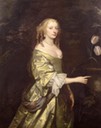
Elizabeth, Lady Wilbraham, née Mytton by Sir Peter Lely (Weston Park - Weston-under-Lizard, Staffordshire, UK)

Vere Lady Isham (d.1704), Wife of 2nd Bt Isham by David Loggan (Lamport Hall - Lamport, Northamptonshire UK)

early 1650s Jemima, 1st Countess of Sandwich (1625-1674) by the Sir Peter Lely studio (Mount Edgcumbe House - Plymouth UK)

Jemima Montagu, née Crewe (1625–1674?), 1st Countess of Sandwich attributed to John Hayls (Hinchingbrooke House - Huntingdon, Cambridgeshire UK)

Catherine Okeover (d.1672), Lady Robert Shirley in the style of Sir Anthonis van Dyck (Sudbury Hall - Sudbury, Ashbourne, Derbyshire, UK)

1653 Magnus Gabriel De la Gardie och hustru Maria Eufrosyne by Hendrik Münnichhoven (location unknown to gogm)

Countess Maria Euphresyne de la Gardie, née av Pfaltz-Zweibrucken, sister of Karl X by Johannes Assman (Skoklosters slott - Skoklosters Sweden)

1652 (after) Giulia Arese Borromeo (1636-1704) sposò Renato II Borromeo by ? (Palazzo Borromeo - Isola Bella sui Lago Maggiore, Streso, Piemonte, Italy)

ca. 1654 Countess Beata Elisabeth von Königsmarck attributed to Hendrick Munnichhoven (Skoklosters slott - Skoklosters Sweden)
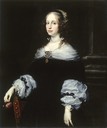
1654 Countess Teresa Dudley di Carpegna by Justus Sustermans (Walters Museum - Baltimore, Maryland USA)

1654 Countess Teresa Dudley di Carpegna by Justus Sustermans (Walters Museum - Baltimore, Maryland USA) head and fichu

1654 Countess Teresa Dudley di Carpegna by Justus Sustermans (Walters Museum - Baltimore, Maryland USA) sleeves

1654-1655 Elisabeth Amalie of Hesse-Darmstadt probably with her daughter Eleonor of the Palatinate by Johann Spilberg (Stadtmuseum Düsseldorf)

1700 Elisabeth Amalia Magdalena, Kurfürstin von der Pfalz by Jan Frans van Douven (Historical Museum of the Palatinate)

ca. 1654 Margaret Spencer (d.1704), Mrs Robert Lucy, later Lady Arundell of Wardour by ? (Charlecote Park - Wellesbourne, Warwick, Warwickshire, UK)

1662-1665 Margaret Spencer, Lady Arundell of Wardour by John Michael Wright (Trerice - Newquay, Cornwall, UK)

Magdeleine d'Angennes, épouse de Henri duc de La Ferté-Senneterre, et Catherine d'Angennes, épouse de comte d'Olonne by ? (Château de Bussy-Rabutin - Bussy-le-Grand, Côte-d'Or department, Bourgogne France)

ca. 1706 Hedvig Eleonora of Holstein-Gottorp, Queen Consort of Sweden by David von Krafft (location unknown to gogm)

1656 Princess Anna Julianna Eszterházy, wife of Count Ferenc Nádasdy by Benjamin von Block (location unknown to gogm)

1657 Henrietta Jermyn by ? (Colchester and Ipswich Museums Service, specific location unknown to gogm)

Anne de La Grange-Trianon, Countess of Palluau and Frontenac by ? (Châteaux de Versailles et de Trianon - Versailles, Île-de-France, France)

1655-1660 Margherita, wife of Baldassare Vandergoes by Luigi Primo (Walters Museum of Art - Baltimore, Maryland, USA)

Noblewoman by Giovanni Bernardo Carbone (Musei di Strada Nuova, Palazzo Bianco - Genova, Liguria, Italy)
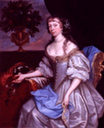
1660 Elizabeth FitzGerald, née Holles, Countess of Kildare by John Michael Wright (location unknown to gogm)

1660-1661 Couple by Bartholomeus van der Helst (Staatliche Kunsthalle Karlsruhe - Karlsruhe, Baden-Württemberg, Germany)
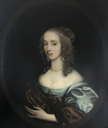
ca. 1640 (?) Anne, Viscountess Bayning by circle of Gerard Soest (sold) From sellingantiques.co.uk/511202/portrait-of-anne-viscountess-bayning-c1640-circle-of-gerard-soest/.png

ca. 1660 Lady, Possibly Elizabeth Trentham, Viscountess Cullen by circle or studio of Sir Peter Lely (sold by Roy Precious)

ca. 1660/1665 Elizabeth Trentham (1640–1713), Viscountess Cullen by Sir Peter Lely (Kingston Lacy - Wimborne Minster, Dorset, UK)

ca. 1660 Hannah Winton by school of Sir Peter lely (Norfolk Museums and Archaeology Service, Norfolk UK)

Eleonora Boncompagni Borghese, half-length, in an embroidered dress by Jacob Ferdinand Voet studio (auctioned by Bonhams)

Maria Anna van Berchem, Countess of Crykenborch by ? (Bowes Museum - Barnard Castle, Teesdale, County Durham, UK)

Lady, traditionally identified as a member of the Colonna family by Jacob Ferdinand Voet (location ?)

Elizabeth, Countess of Grammont by John Giles Eccardt after Sir Peter Lely (National Portrait Gallery, London)

Lady Elisabeth Hervey by Wenceslas Hollar after Sir Anthonis van Dyck (Thomas Fisher Rare Book Library, University of Toronto - Toronto, Ontario Canada)

1663 (estimated) Anne de Gonzagues-Cleves Comtesse Palatine du Rhin by the Beaubrun brothers studio (Versailles)

1662-1665 Frances Teresa Stewart, Duchess of Richmond and Lennox by Sir Peter Lely (Royal Collectiom)

1664-1665 Konstancja Krystyna Wielopolska, née Komorowska by Pierre Mignard (Muzeum Norodowe w Kielcach - Kielce, Województwo świętokrzyskie, Poland)

1660s (probably) Baroness Ingeborg Axelsdotter Baner by David Klöcker Ehrenstrahl (Skoklosters slott - Skoklosters Sweden)

ca. 1665 Windsor Beauty Frances Brooke, Lady Whitmore by Sir Peter Lely (Royal Collection - Hampton Court Palace, Richmond upon Thames, London, UK)

1665 Diane Kirke, Countess of Oxford by Sir Peter Lely (Yale University Mellen Center for British Art - New Haven, Connecticut, USA)

Young Lady called Henrietta Boyle by Christian Friedrich Zincke (Denver Art Museum - Denver, Colorado, USA)

Engraving of the Duchess of Newcastle is in The Lives of William Cavendishe, Duke of Newcastle, and of his Wife, Margaret Cavendish, Duchess of Newcastle edited by Mark Anthony Lower
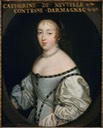
Catherine de Neufville (1639-1707), comtesse d'Armagnac by the Beaubrun brothers studio (Versailles)

Francesca Greppi Fani, also called Sophia Dorothea of Celle, after Jacob Ferdinand Voet (location unknown to gogm)

Maria Ortensia Biscia del Drago attribué à Jacob Ferdinand Voet (Musée des Beaux-Artes - Nantes, France)
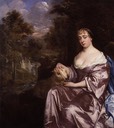
ca. 1665 Unknown woman, formerly known as Elizabeth, Countess of Grammont by Sir Peter Lely (National Portrait Gallery - London UK)

1660s (early to middle estimated period) Albertine Agnes (1634-1696), Princess of Oranje-Nassau and her three children by Abraham van den Tempel (Fries Museum Leeuwarden)

1660s Countess Simonetta Cavazzi della Somaglia by Pierfrancesco Cittadini (Porczyński Gallery - Warsawa, Poland)

Infanta of Spain by an imitator of Agnolo Bronzino (1503–1572) Nottingham Castle Museum and Art Gallery - Nottingham, Nottinghamshire, UK)

1665-1670 Lady Anna Maria Brudenell (1642–1702), Countess of Shrewsbury Sir Peter Lely (Cliveden - Taplow, Buckinghamshire, UK)

ca. 1670 Anna Maria (Brudenell), Countess of Shrewsbury by Sir Peter Lely (National Portrait Gallery, London)

1667 Countess Elizabeth Wilmot, née Malet (also known as Elizabeth Mallet), portrait by Sir Peter Lely (location unknown to gogm)

1660s (late) Lady Penelope Spencer by Sir Peter Lely (Minneapolis Institute of Art - Minneapolis, Minnesota, USA)
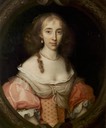
1669 Magdalen Aston, Lady Burdett by John Wright (Nottingham City Museums and Galleries Nottingham Castle, Nottingham UK)

1670 Dudleia Cullum, née North, Lady Cullum by Sir Peter Lely (St Edmundsbury Museums - St Edmundsbury, Suffolk UK)

ca. 1670 Principessa Laura Caterina Altieri by Jacob Ferdinand Voet (Museo del Settecento Veneziano, Venizia)

ca. 1670 Mary Bagot, later Countess of Dorset attributed to John Michael Wright (Holburne Museum - Bath UK)

ca. 1670 Miss Vere Isham (1655–1674), daughter of 2nd Bt Isham by circle of Sir Peter Lely (Lamport Hall - Lamport, Northamptonshire UK)

1670 Lady Elizabeth Cranfield, 1647/1648–1670, Viscountess Brackley (?) attributed to Mary Beale (Tatton Park - Tatton, Cheshire East UK)

Duchess Of Richmond by Sir Peter Lely (Christchurch Art Gallery Te Puna o Waiwhetu - Christchurch, South Island New Zealand)

ca. 1670 Lady Jane (Anne) Powlett by circle of Sir Peter Lely (Ashridge Business School, Egerton collection - Berkhamsted, Hertfordshire UK)

ca. 1670 Lady, possibly Bridget Cockayne, wife of the Rev. Hon, John Feilding by studio of Sir Peter Lely (private collection)

1671 Lady Diana Bruce (d.1672) by Sir Peter Lely (National Galleries of Scotland - Edinburgh Scotland)

ca. 1670 Claire Isabelle Pac, née Lascaris de Mailly-Lespine after Daniel Schulz (Lietuvos nacionalinis muziejus - Vilnius, Lithuania)

ca. 1670 Original Claire Isabelle Pac, née Lascaris de Mailly-Lespine by Daniel Sculttz (M. K. Čiurlionis National Art Museum - Kaunas, Kauno apskritis, Lithuania)

Lady Frances Norcliffe (1654-1731), bust-length, in a pale blue dress with a pearl clasp by Sir Peter Lely (auctioned by Christie's)

Honourable Mrs. Grimston, née Elizabeth Finch, later Lady Elizabeth Grimston by Sir Peter Lely (auctioned by Christie's)

1672 Mary Elizabeth Browne, Lady Teynham who married Christopher Roper by John Michael Wright (auctioned by Sotheby's)

1670s Catherine de Neufville, Comtesse d'Armagnacq by Joseph Parrocel (Skoklosters slott - Skoklosters Sweden)

1670s Anne de Souvré, marquise de Louvois by Joseph Parrocel (Skoklosters slott - Skoklosters Sweden)

Anna Maria Carpegna Naro (1651-1731) half length, wearing a dress with fine lace and pink bows by Jacob Ferdinand Voet (auctioned by Sotheby's)

1670s Katherine Elisabeth, Countess of Auersperg, née von Trilleck by ? (Palača Kresija, Narodna galerija - Ljubljana, Slovenia)

1670s (early) Mary Wither of Andwell by Mary Beale (Art Gallery of South Australia - Adelaide, South Australia, Australia)

La Marchesa Sacchetti, possibly Clelia Orsini de' Cavalieri, by Jacob Ferdinand Voet (Palazzo Chigi - Roma, Italy)

1670s Anna Eleonore of Stolberg-Wernigerode with a pearl necklace and sable coat by ? (Muzeum Narodowe w Warszawie - Warsawa, Poland)

Double Portrait of Charles, 5th Earl of Haddington and Margaret, Countess of Rothes by circle of John Michael Wright (Clan Leslie Charitable Trust - Leslie, Fife UK)

1674 Contessa Giustina Colonna Riccati by Sebastiano Bombelli (Museo Civico di Castelfranco Veneto - Castelfranco Veneto, Provence of Treviso Italy)

ca. 1674 Duchesse d'Aumont (1650–1711) by Justus van Egmont (Bowes Museum - Barnard Castle, County Durham, UK)

Françoise-Angélique de la Mothe-Houdancourt, duchesse d'Aumont by Justus van Egmont (Musée Condé - Chantilly, Picardie, France)

1670s Françoise Angélique de La Mothe Houdancourt, madame la duchesse d'Aumont by Pierre Mignard (Skoklosters slott - Skokloster, Sweden)

1670s Marie Isabelle Angélique de Lamothe-Houdancourt, madame la duchesse de la Ferté by Joseph Parrocel (Skoklosters slott - Skokloster, Sweden)

ca. 1712 (based on ages of children) Duuchessa de La Ferté con Luigi duca di Bretagna, il più grande, e Luigi duca d'Angiò by François de Troy (location ?)

ca. 1675 Lady Mary Hay, née Maitland (1645–1702), Marchioness of Tweedale by Mary Beale (St Edmundsbury Museums - St Edmundsbury, Suffolk UK)

1675 Magdalena Sibylla von Hessen Darmstadt (1652-1712) wife of Duke Wilhelm Ludwig and guardian of the minor Eberhard Ludwig (Landesmuseum Württemberg, Stuttgart)

Christian Leslie, Lady Bruce (1661-1710) attributed to John or David Scougal (Clan Leslie Charitable Trust - Leslie, Fife UK)

Lady Christian Leslie, Marchioness of Montrose by follower of Sir John Baptiste Medina (Clan Leslie Charitable Trust - Leslie, Fife UK)

Lady, said to be the Marchioness of Montchevreuil, three-quarter-length, beside a fountain attributed to Justus van Egmont (auctioned by Sotheby's)

1670s unknown noble lady (perhaps a member of the Auersperg family) by the Almanach painter (location ?)

ca. 1675 Anna Caffarelli Minuttiba by Jacob Ferdinand Voet (Fine Arts Museums of San Francisco, Palace of the Legion of Honor - San Francisco, California USA)

ca. 1675 Lady, traditionally identified as Sophia Bulkeley by Jacob Ferdinand Voet (private collection)

Elizabeth Washington (c.1655–1693), Lady Ferrers, as Minerva after Michael Wright (Sudbury Hall - Sudbury, Ashbourne, Derbyshire, UK)

Principessa Maria Isabella Massimo Muti Papazzurri by Jacob Ferdinand Voet (auctioned by Christie's)

1670s Unknown noble lady, perhaps a member of the Auersperg family by the Almanach painter (location ?)

Grace Wilbraham, later Countess of Dysart, by John Michael Wright (Chirk Castle - Chirk, Wrexham (Wrecsam), UK)

ca. 1678 Erzherzogin Maria Anna Josepha by ? (Stadtmuseum Landeshauptstadt Düsseldorf - Düsseldorf, Nordrhein-Westfalen, Germany)

ca. 1678 Maria Anna de La Grange d'Arquien by Claude Callot (Muzeum Norodowe w Kielcach - Kielce, Województwo świętokrzyskie, Poland)

1680s Anna Wielopolska attributed to Claude Callot (Muzeum Pałacu Króla Jana III w Wilanowie - Warszawa, Poland)

ca. 1680 Lady Elizabeth Noel, née Wriothesley by Charles Beale after Sir Peter Lely (Lewis Walpole Library, Yale University, New Haven Connecticut)

1680 Fille de Qualité by Henri Bonnart (Los Angeles County Museum of Art - Los Angeles, California USA)

ca. 1680 Pfalzgräfin Benedikta Henriette von Simmern, Herzogin von Braunschweig-Calenberg by ? (Royal collection)

ca. 1680 Catherine, née Purcell, Lady Copley (1657-1699) by circle of Caspar Netscher (sold by Roy Precious)

Lady, full-length, in a red and gold brocade dress by Pier Francesco Cittadini (auctioned by Bonhams)

ca. 1681 Ludwika Karolina Radziwil by ? (Zamek w Kórniku or Zamek Kórnicki - Kórnik, Wielkopolska, Poland)
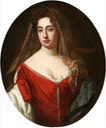
Charlotte FitzRoy, Countess Lichfield (1664–1718), Countess of Lichfield by Sir Godfrey Kneller (Hatchlands Park - East Clandon, Guildford, Surrey UK)











